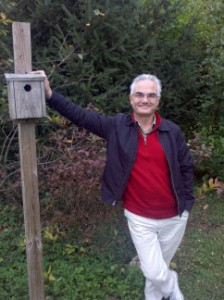Why am I writing this?
To help the beauty of creation, one bird and one butterfly at a time.
Anyone with even the smallest back yard, the tiniest garden, can make a difference for wildlife. Because wild things have fewer and fewer places to go – so it is up to us to help them.
Birds and butterflies, fish, ferns and frogs, ladybugs and lacewings, hawk moths and hoverflies.
How? Well, let’s step back, first, and take a look at what surrounds your house and mine, most of the time.
In the suburbs, man has been domesticated by the common or garden lawn grass. We are its creatures; we trim it, we feed it, we ensure that no other plant crowds it and mars its perfect greenness, and we terminate any insect that dares to crop it. Even if we might admire a natural, wooded landscape on an opposing hillside, we prefer our own yard to be a pristine green sward. In fact, together with a deck and grill, owning such a lawn is the dream of most Americans.
And of most Britons too … speaking as someone who was born in England but who lives in Pennsylvania, we did, after all, start this obsession!
So what? Well, ironically, many of us are also concerned about eating organically. There is a disconnect between avoiding suspect chemicals in our food, and wanting to keep the lawn perfect…whatever the chemical ‘cost’. Unfortunately, the herbicides and pesticides that lawn companies use will also have an effect on the wider world – whether it be depleting the food sources of the springtime robins and autumn finches, or trickling into watercourses and our ground water to surprise us with accumulating toxicity.
In addition, the other maintenance of the lawn (all that lawn mowing!) creates its own toll on the environment.
And what about the rest of your yard – mulching and planting water-hungry annuals each year … is this the best use of your time and money? I don’t think you have to be a master landscape gardener to wonder if there mightn’t be a better way.
How about cultivating something that’s a little more beautiful….and a little less work….and help the environment too?
And I do mean help! The yard is one of the areas where householders can make a deeply positive impact.
This is what this web site is about. It is intended to be a clearing house for all solid advice on wildlife gardening – that is, gardening for beauty and nature.
Picture of a Ruby Throated Hummingbird sipping nectar from Bee Balm (Monarda) by Joe Schneid
Questions? Comments? E-mail me on johnnydogmatic@comcast.net
Picture below – the author, standing by a native ‘copse’ in East Brandywine, Pennsylvania, October 8th, 2012

